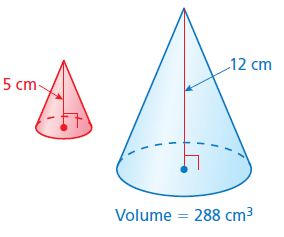FIND SURFACE AREA AND VOLUME OF SIMILAR SOLIDS
Subscribe to our ▶️ YouTube channel 🔴 for the latest videos, updates, and tips.
If two figures are similar then:
- the figures are equiangular, and
- the corresponding sides are in proportion.
Surface area of similar figures :
If two solids are similar, then the ratio of their surface areas is equal to the square of the ratio of their corresponding linear measures.

Volume of similar figures :
If two solids are similar, then the ratio
of their volumes is equal to the cube
of the ratio of their corresponding
linear measures.
The scale factor between two similar figures is given. The surface area and volume of the smaller figure are given. Find the surface area and volume of the larger figure.
Problem 1 :
Scale factor = 1 : 2
SA = 90 yd2
V = 216 yd3
Solution :
Scale factor (k) = 1 : 2 = 1/2
i) Surface area of smaller figure / surface area of larger
= (1/2)2
Surface area of smaller figure = 90 yd2
90/Surface area of larger figure = (1/4)
Surface area of larger figure = 90(4)
= 360 yd2
So, surface area of larger figure is 360 yd2.
ii) Volume of smaller figure / Volume of larger = (1/2)3
Volume of smaller figure = 216 yd3
216/volume of larger figure = (1/8)
Volume of larger figure = 216(8)
= 1728 yd3
So, volume of larger figure is 1728 yd3.
Problem 2 :
Scale factor = 4 : 9
SA = 256 km2
V = 1536 km3
Solution :
i) Surface area of smaller figure / surface area of larger
= (4/9)2
Surface area of smaller figure = 256 km2
256/Surface area of larger figure = (4/9)2
Surface area of larger figure = 256(81/16)
= 1296 yd2
So, surface area of larger figure is 1296 yd2.
ii) Volume of smaller figure / Volume of larger = (4/9)3
Volume of smaller figure = 1536 yd3
1536/volume of larger figure = (64/729)
Volume of larger figure = 1536(729/64)
= 17496 km3
So, volume of larger figure is 17496 km3.
Problem 3 :
The dimensions of the touch tank at an aquarium are doubled. What is the volume of the new touch tank?
A) 150 ft3 B) 4000 ft3 C) 8000 ft3 D) 16,000 ft3

Solution :
The dimensions are doubled, so the ratio of the dimensions in the original tank to the dimensions in the new tank is 1 : 2.
(Original volume/new volume) = (original dimension/new dimension)3
(2000/new volume)= (1/2)3
(2000/new volume)= (1/8)
New volume = 2000(8)
= 16000 ft3
The solids are similar. Find the volume of the red solid. Round your answer to the nearest tenth.
Problem 4 :

Solution :
Scale factor (k) = 5/12
Volume of red solid / volume of blue solid = k3
Volume of red solid / 288 = (5/12)3
Volume of red solid / 288 = 125/1728
Volume of red solid = (125/1728)⋅288
= 20.8 cm3
Problem 5 :

Solution :
Scale factor (k) = 3/4
Volume of blue solid / volume of red solid = k3
9 / Volume of red solid = (3/4)3
9 / Volume of red solid = (27/64)
Volume of red solid = 9(64/27)
= 21.3 in3
Subscribe to our ▶️ YouTube channel 🔴 for the latest videos, updates, and tips.
Recent Articles
-
Finding Range of Values Inequality Problems
May 21, 24 08:51 PM
Finding Range of Values Inequality Problems -
Solving Two Step Inequality Word Problems
May 21, 24 08:51 AM
Solving Two Step Inequality Word Problems -
Exponential Function Context and Data Modeling
May 20, 24 10:45 PM
Exponential Function Context and Data Modeling